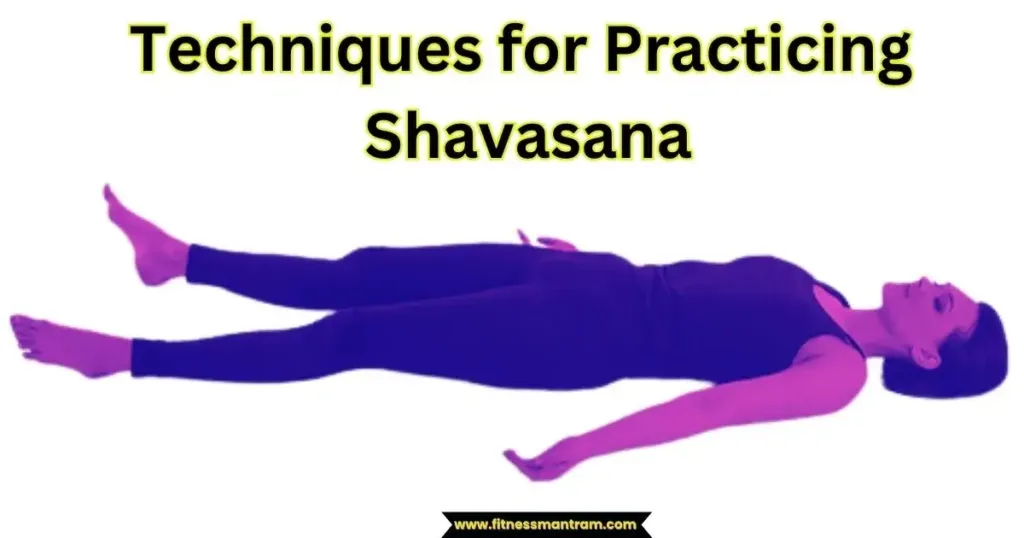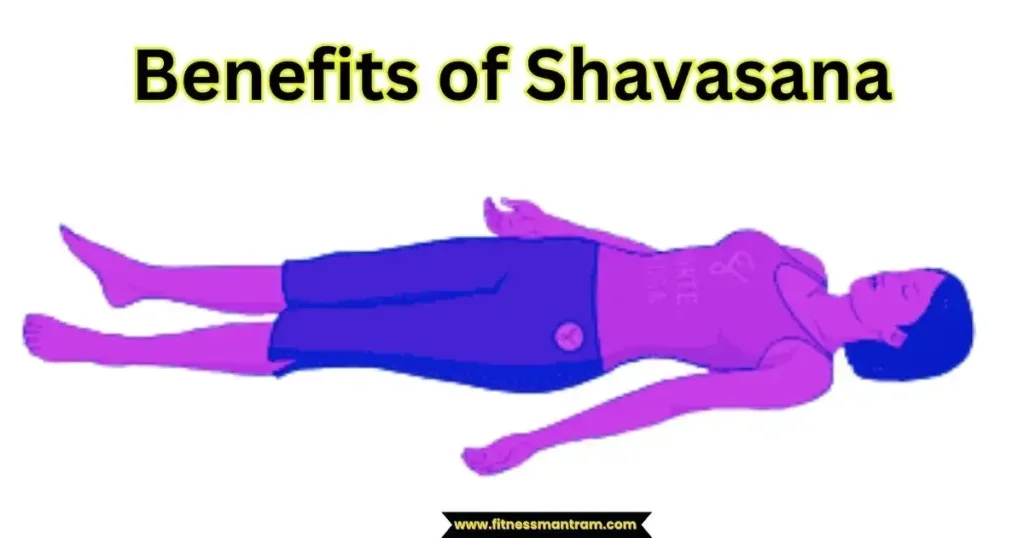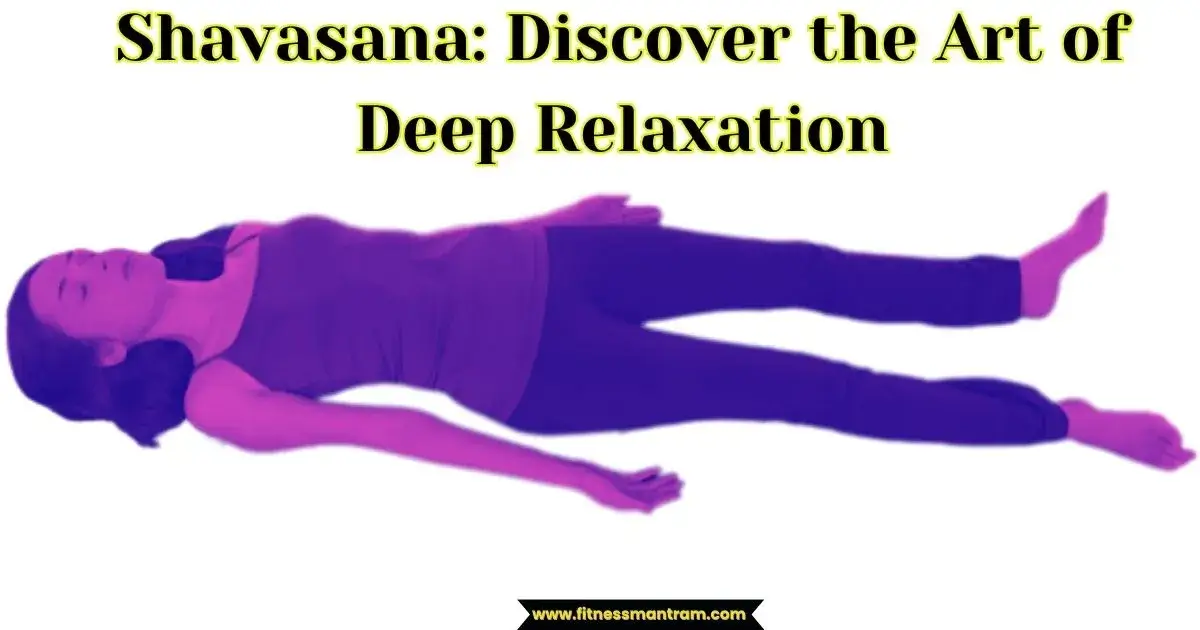Welcome to the world of Shavasana, the ultimate relaxation technique that can help you achieve deep rest and rejuvenation. Learn the art of deep relaxation as we unlock the power of Shavasana in this complete detailed article. While practice and performing this asana you will embrace the blissful essence of shavasana and you will enter in to the gateway to inner peace and total well-being.
What is Shavasana?
Shavasana, also known as Corpse Pose, is a quintessential posture practiced in yoga and meditation. Derived from Sanskrit, “Shava” means “corpse,” and “asana” refers to a yoga pose. Contrary to its macabre name, It is a practice of conscious relaxation aimed at calming the mind, releasing tension, and promoting overall well-being. This asana is a practice of surrendering to relaxation and finding inner peace. Embrace its transformative power and enjoy the journey toward a calmer and more balanced life.
In this asana, the practitioner lies flat on their back, with arms relaxed by the sides and legs comfortably apart. The body is completely at rest, mimicking the stillness of a lifeless body. The aim is to create a state of profound relaxation while maintaining awareness and clarity of mind. It is typically performed at the end of a yoga session or as a standalone practice. It serves as a transitional pose that allows the body and mind to integrate the benefits of the preceding yoga postures and pranayama (breathing exercises).
The Importance of Shavasana
Due to the numerous advantages, it offers in terms of physical, mental, and emotional well-being, it holds a significant place in yoga and meditation. Let’s explore why this practice is so highly regarded and cherished by practitioners worldwide.
- Deep Relaxation: This Asana allows the body and mind to enter a state of deep relaxation. By consciously releasing physical and mental tension, practitioners experience a profound sense of calmness and tranquillity. This practice promotes restful sleep, reduces fatigue, and enhances overall energy levels.
- Stress Reduction: In today’s fast-paced world, stress has become a common companion for many individuals. It provides an oasis of peace amidst the chaos, helping to alleviate stress and anxiety. By focusing on the breath and letting go of worries, practitioners cultivate a state of mindfulness and inner peace.
- Improved Concentration and Focus: Regular practice of this asana enhances mental clarity, concentration, and focus. By practicing daily individuals can trained their mind to stop and let go distracting thoughts and avoid themselves to surrender to their current unwanted situation by developing their ability to stay attentive and focused in their daily lives
- Enhanced Body Awareness: This Asana brings awareness to the body and its sensations. By consciously relaxing each body part and scanning for areas of tension, practitioners develop a deep connection with their physical being. This heightened body awareness promotes better posture, physical alignment, and overall body-mind harmony.
Techniques for Practicing Shavasana
Now that we understand the significance of Shavasana let’s explore some techniques to help you practice this rejuvenating pose effectively.

- Preparation: Before you start doing shavasana select a comfortable place where no one can disturb you. Lie down on your back with your legs extended and slightly apart. Allow your arms to relax alongside your body, palms facing up. Make sure you are warm and cozy, using a blanket or cushion if needed.
- Progressive Muscle Relaxation: Start by consciously relaxing each part of your body, starting from your toes and gradually moving up to your head. Keep your attention on each and every body parts, tensing it for few seconds, before completely releasing the tension. This technique helps release any physical tension and prepares you for deep relaxation.
- Breath Awareness: Shift your focus to your breath. Observe the natural rhythm of your breath without trying to control or manipulate it. Notice the sensation of the breath entering and leaving your body. If your mind wanders, gently bring your attention back to the breath, allowing any thoughts or distractions to pass by without attachment.
- Mental Visualization: Engage in mental visualization to deepen your relaxation experience during Shavasana. While performing imagine yourself to be in a peaceful serene like a beautiful beach or a lush forest near beautiful river flowing around. Visualize the sights, sounds, and smells of this tranquil environment, allowing your mind to wander and find solace in the imagery.
- Letting Go of Thoughts: As you continue to rest in Shavasana, thoughts may arise in your mind. Instead of getting caught up in them, practice the art of letting go. Imagine each thought as a passing cloud in the sky, gently drifting away without any attachment. By cultivating a non-judgmental and accepting attitude towards your thoughts, you create space for deep relaxation.
- Duration: Ideally, Shavasana should be practiced for at least 10-15 minutes to fully reap its benefits. However, you can extend the duration based on your comfort and availability. Allow yourself ample time to immerse in the stillness and surrender to the practice.
Tips for an Effective Shavasana Practice
To optimize your Shavasana experience and harness its potential, consider the following tips:
- Create a Sacred Space: Designate a specific area in your home or practice space for Shavasana. Make it sacred by adding elements that promote relaxation, such as soft lighting, calming music, or aromatherapy. This dedicated space will signal your mind and body that it’s time to unwind and let go.
- Consistency is Key: Make Shavasana a regular part of your daily or weekly routine. To get better results and benefits it is necessary to practice consistently for loner period. Set aside dedicated time for relaxation and prioritize self-care.
- Customize for Comfort: Modify the posture to suit your body’s needs. If lying flat on the floor is uncomfortable, you can place a bolster or folded blanket under your knees for extra support. Experiment with different variations until you find the most comfortable position for deep relaxation.
- Disconnect from Distractions: During your Shavasana practice, ensure you are free from distractions. Silence your phone, turn off notifications, and create a technology-free environment. This will help you to participate fully in your practice without any distractions and interruption.
- Seek Guided Shavasana Meditations: If you find it challenging to relax on your own, consider using guided Shavasana meditations. Numerous apps, websites, and meditation platforms offer pre-recorded sessions specifically designed to guide you into a state of deep relaxation.
Shavasana Procedure Benefits and Contraindications
Shavasana, also known as Corpse Pose, is a relaxation posture commonly practiced at the end of a yoga session. In this asana while performing you need to lie flat on your back with your eyes closed, your arms and legs relaxed in position. Here is the procedure, benefits, and contraindications associated with Shavasana:
Procedure:
- Find a quiet and comfortable space to lie down on your back, preferably on a yoga mat or a soft surface.
- Keep your legs slightly apart and allow your feet to fall open naturally.
- Place your arms alongside your body, with your palms facing up, and allow your fingers to curl naturally.
- Close your eyes gently and bring your attention to your breath.
- Relax your entire body, starting from your toes and moving up to your head. Release any tension you may be holding.
- Stay in this pose for about 5 to 15 minutes, or as long as you feel comfortable.
- When you’re ready to come out of Shavasana, gently deepen your breath, wiggle your fingers and toes, and roll onto your right side. Take a few moments to transition before slowly sitting up.
Benefits of Shavasana:

- Relaxation: Shavasana promotes deep relaxation and helps calm the mind, reducing stress and anxiety.
- Restores energy: By allowing your body and mind to rest completely, Shavasana helps replenish energy levels.
- Reduces blood pressure: The relaxation achieved during Shavasana can help lower blood pressure and improve cardiovascular health.
- Enhances focus and concentration: By clearing the mind and releasing tension, Shavasana can improve mental clarity and focus.
- Relieves physical tension: This pose helps relax the muscles and release physical tension or tightness in the body.
- Facilitates mindfulness: Shavasana provides an opportunity to cultivate mindfulness, awareness of the present moment, and body-mind connection.
Contraindications:
Although many people find Shavasana to be safe, there are a few things to keep in mind:
- Pregnancy: Before performing Shavasana during pregnancy, especially in the later stages, it is advisable to consult with a qualified prenatal yoga instructor or healthcare provider for their proper guidance and suggestion.
- Back Issues: Individuals with severe back pain or injury should use caution or consult a healthcare professional before practicing Shavasana. Using props like a bolster or rolled-up blanket under the knees can provide additional support.
- Low Blood Pressure: If you have low blood pressure, be cautious when transitioning into and out of Shavasana, as sudden changes in position may cause dizziness or light-headedness.
- Respiratory Conditions: People with respiratory problems, such as asthma or chronic obstructive pulmonary disease (COPD), should practice Shavasana with awareness and avoid any discomfort or breathlessness.
It is always advisable to consult with a medical personal before you start to practice any kind of yoga practice or other exercise especially If you have any medical issues
What Do You Mean by Shavasana Explain Yoga Nidra ?
Shavasana, or Corpse Pose, is a type of a yoga relaxation pose in which you have to lie on your back keeping your eyes closed with your arms and legs in relaxed position. It is a state of conscious relaxation techniques which enables the mind and body to completely relax and get into a deep sleep.
Yoga Nidra, on the other hand, is a specific technique of guided meditation that goes beyond the relaxation achieved in Shavasana. It is also known as “psychic sleep” or “yogic sleep.” While performing this asana your body is completely in relaxed state, but your mind is still awake and open. In short, we can say “Yoga Nidra” is a state of conscious awareness that occurs between wakefulness and sleep.
During a Yoga Nidra practice, you typically lie down in Shavasana and follow the guidance of a teacher or a recorded audio. During the practice of shavasana the yoga instructor will guide you through a series of instructions, like body awareness, breath awareness, visualization, and conscious relaxation. So as to get you in to a state of deep relaxation and heightened awareness. Yoga Nidra is basically used to relax your mind, body and emotions by increasing self-awareness and mental clarity. It allows you to explore the layers of consciousness and tap into your subconscious mind, where deep healing and transformation can occur.
Yoga Nidra offers numerous benefits, including stress reduction, improved sleep, enhanced focus and concentration, increased creativity, emotional healing, and deep relaxation. The management of PTSD, anxiety, and other mental health related issues are overcome with the help of this therapeutic tool.
Yoga Nidra can be practiced by anyone, regardless of age or physical fitness level. Due to its ability to give people a chance to recharge, reenergize, and find inner peace, it is especially beneficial for people who had busy and stressful lives.
Before starting keep in mind that you should consult with a yoga instructor the proper form and technique and how to perform this asana, initially you should start practice Yoga Nidra under the supervision of a trained instructor so as to get their proper instruction and guidance throughout the practice. There are also number of self-practicing guided Yoga Nidra recordings available for reference
Conclusion
Shavasana, the art of deep relaxation, has the power to transform your well-being by providing profound rest and rejuvenation. After regular practice for few months, you will experience reduced stress, improved concentration, and enhanced body-mind awareness. Remember to make Shavasana a priority, invest time in its practice, and allow yourself to fully surrender to the blissful state of conscious relaxation. Embrace the stillness, embrace the calmness, and let Shavasana guide you towards a more balanced and peaceful life.
Frequently Asked Questions
Q1: Can anyone practice Shavasana?
A1: Absolutely! Shavasana can be practiced by individuals of all ages and fitness levels. It is a gentle and accessible pose that requires no prior experience in yoga or meditation. Whether you’re a beginner or an experienced practitioner, Shavasana offers profound relaxation benefits for everyone.
Q2: When is the best time to practice Shavasana?
A2: The beauty of Shavasana is its flexibility. You can practice it any time of day If you are at a quiet and comfortable space. Many people prefer practicing Shavasana at the end of their yoga or exercise session to allow the body and mind to integrate the benefits of the practice. However, you can also practice it independently as a standalone relaxation technique.
Q3: How long should I stay in Shavasana?
A3: While the ideal time to stay in this pose is between 10 and 15 minutes, but you can stay in Shavasana for long duration depending on your personal preference and availability. If you have more time, feel free to extend the duration to deepen the relaxation experience. However, even if you practice this shavasana just a few minutes it will help to relax your body and mind.
Q4: What if I fall asleep during Shavasana?
A4: Falling asleep during Shavasana is not uncommon, especially if you’re feeling tired or fatigued. It’s a sign that your body and mind need rest. It is perfectly ok if you do fall asleep. Secondly, if you want to remain in awake and relaxed position, you can try it in a slightly elevated position or with your knees bent.
Q5: Can Shavasana help with anxiety and stress?
A5: Yes, Shavasana is an excellent practice for reducing anxiety and stress. Shavasana activates the parasympathetic nervous system, which help to promotes a state of calm and relaxation, through conscious body relaxation and breath focus. You can develop coping mechanisms for stress management and promote emotional well-being with regular practice.
Q6: Is it necessary to practice other yoga poses before Shavasana?
A6: Shavasana can be practiced independently or as part of a yoga sequence. While it’s not necessary to perform other poses before Shavasana, incorporating a few gentle stretching or relaxing poses can help prepare the body for deep relaxation. However, if you’re short on time, you can go directly into Shavasana and still receive its benefits.
It is always advisable to speak and consult with a professional health care personal or a certified yoga instructor before starting the new yoga practice or any other exercise routine.
Read More :
- A Celebration of Mind, Body, and Spirit
- Ultimate Guide to this Ancient Yoga Pose
- 10 Amazing Benefits of Padmasana
- Unleashing the Power of the Bow Pose
- Discover the Healing Power of Gomukhasana
Disclaimer : The details & information given here in this article is based on information as available on other published site on internet. Do take medical advice before adopting it. Fitness Mantram Does Not Confirm It. This site contains affiliate links. If you choose to make a purchase after clicking a link the author/owner/creator may receive a commission at no ADDITIONAL cost to you. Thank you for your support!

1 thought on “Shavasana- Discover the Art of Deep Relaxation”